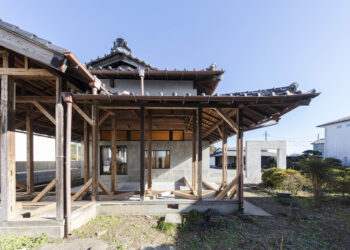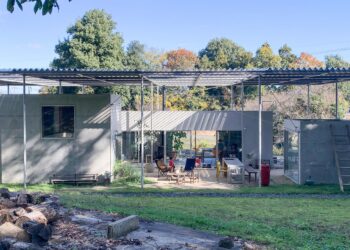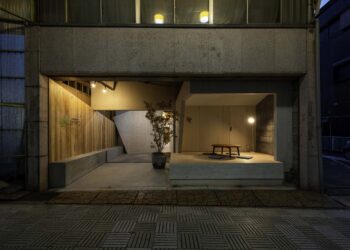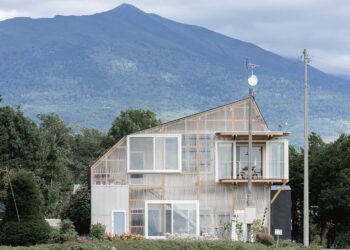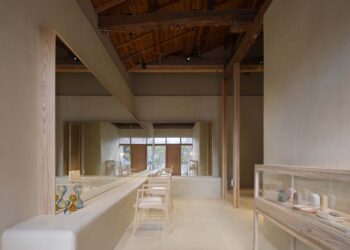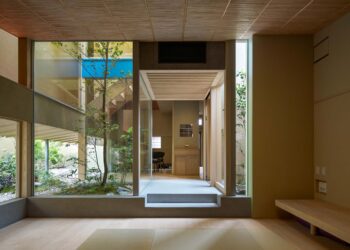A house which acts as a park
공원을 닮은 집
n o t architects studio | 엔오티 아키텍츠 스튜디오

When one takes a walk in the park, one chooses where to stop and rest, or how to spend ones time, depending on the weather, the season, and time of day. ‘Weather House’ is a proposal for a house that takes characteristics from such a walk in the park.
The site is a corner of a small residential area in Tokyo. Nearby are two parks, a larger one and smaller one, connected by a long walkway. The park and the walkway blend in with the surrounding residential area while creating an environment that is unique to the place. Therefore, the architects decided to gently draw the walkway from the front of the house into the entire building.
우리는 공원을 산책할 때 쉴 곳을 찾아 다니기도 하고, 날씨나 계절, 그리고 시간에 따라 어떻게 시간을 보내야 할 지 고민한다. 이 집은 이렇게 공원을 산책하는 동안 일어나는 일련의 활동에서 영감을 얻어 설계하였다.
부지는 도쿄의 자그마한 주거지역 한 켠이다. 주택과 가까운 곳에는 큰 공원 하나와 작은 공원 하나가 있으며, 이 두 공원은 긴 산책로로 연결되어 있다. 이 공원과 산책로는 주변 주거지역에 잘 스며들어 있어 이 곳만의 개성 있는 분위기를 형성하고 있다. 건축가는 집 앞에서부터 건물 전체를 이 산책로의 연장선으로 설계하기로 했다.



The distinction between the house and the pavement is ambiguous. Like in a park, where slopes and squares appear as one is walking around, the stairs in the house, which are all different in shape, gradient and width, are arranged to loosely connect the spaces of the entire building.
Being a corner plot, the two street-facing façades are made of a chain link wire mesh, while the two rear walls are reinforced concrete. The mesh façade/fence wraps around the two sides of the house, reducing further the distinction between private and public spaces. The fencing material can be covered in vine plants, so as to envelope the house and conceal it from the rest of the road, which also allows the vegetation to change according to the seasons.




집 앞으로 난 길과 주택과의 경계가 흐릿하다. 공원에서 산책을 하다 보면 경사지나 광장을 마주하게 되듯, 이 집 곳곳에 흩어져 있는 공간들은 높낮이, 너비, 그리고 형태까지 저마다 다른 계단을 통해 느슨하게 연결되어 있다.
이 부지는 모퉁이에 자리하고 있다. 도로를 향해 난 외관 두 곳은 체인 연결형 메쉬망으로 마감하였으며, 나머지 두 후면은 철근 콘크리트로 마감하였다. 메쉬망 울타리로 마감한 외관이 사적인 공간과 공공 공간의 경계를 무너뜨린다. 울타리를 따라 덩굴 식물이 자라면서 주택을 아늑하게 감싸면 웨더 하우스는 도로로부터 몸을 숨기게 될 것이다. 덩굴 식물은 계절이 지나며 각기 다른 색으로 옷을 갈아 입는다.
철근 콘크리트로 마감한 외관에 자리한 공간은 다른 공간으로부터 고립되어 있어 사생활을 확실히 보장할 수 있다. 이 구조물은 서서히 도시의 일부로 스며들도록 설계되었다.





두 얼굴을 모두 가진 이 주택은 사용자가 기분이나 용도에 따라 머물고 싶은 공간을 선택할 수 있다. 각 공간을 연결하는 길의 너비는 길을 따라 심어 놓은 식물과 계절, 그리고 날씨에 따라 변화한다. 지붕에는 잔디밭을 조성하였다. 때로는 앉아서 주변 경치를 감상할 수 있는 언덕이 되기도 하고, 때로는 사람들이 모이는 공원의 광장 같은 역할을 하기도 한다. 공원과 마찬가지로, 환경이 변화함에 따라 이 주택을 사용하는 방법도 지속적으로 변화한다.
공원의 산책로처럼 다채로운 환경을 단일 건물 내에서 만끽할 수 있어 도시와는 적절한 거리를 유지하면서도 가족 간의 유대감은 강화할 수 있다.

The interior spaces closest to the reinforced concrete sides of the building experience greater privacy, being more secluded. The structure is designed to gradually blend into the city.
The two sides of the house are different from each other, and one can go around the house to find a preferred place to stay. Thanks to the vegetation and the environmental conditions, the paths connecting each space can become wider or narrower depending on the weather and the season. On the roof is a grassy mound. At certain times, this can function as a hill to sit on, to admire the surrounding scenery. At other times, it can become a park square where everyone can gather. As in a park, its usage continues to change with the environment.
By finding a place to live in an environment that keeps changing, like a walkway in a park but within a single building, this creates a new sense of distance from the city and alters the relationship dynamics within the family.
As various lifestyle changes are expected in the future, the architects wanted the residents to spend time in their new home freely discovering how the spaces work for them within their new home.
Project: Weather House / Architecture: n o t architects studio / Location: Tokyo, Japan / Design team: Tetsushi Tominaga, Lisa Ono, Aoi Nahata / Concept design: Lisa Ono / Consultant: Kinoshita structural engineers / Contractor: MARUKOU / Use: Residence / Site area: 82.57m² / Bldg. area: 57.29m² / Gross floor area: 165.93m² / Completion: 2021 / Photography: Yasuhiro Takagi





























